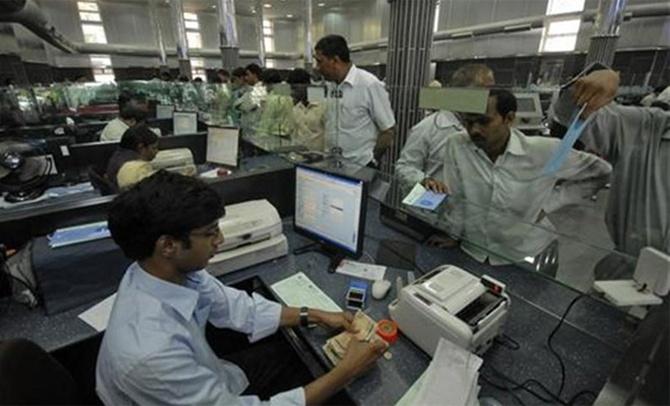 | « Back to article | Print this article |
Privatisation or consolidation into half a dozen large banks might not rescue public sector banks from the crisis they find themselves in, says A V Rajwade.
 A couple of months ago, in an interview on CNBC, Reserve Bank of India (RBI) Governor Raghuram Rajan said the central bank had developed and vetted with outside help, a value-at-risk (VaR) model to measure the price risks it faced in conducting its operations, in order to arrive at the balance sheet reserves it needed.
A couple of months ago, in an interview on CNBC, Reserve Bank of India (RBI) Governor Raghuram Rajan said the central bank had developed and vetted with outside help, a value-at-risk (VaR) model to measure the price risks it faced in conducting its operations, in order to arrive at the balance sheet reserves it needed.
This was done to help decide the profit that could safely be transferred to the owner, namely the government of India.
After watching the interview, I tried to get some information on the issue and find out what the provocation was for creating such a model.
However, I could not get much information. I was curious because VaR models are a standard methodology for measuring the price risk in a commercial bank's trading book: Trading is, of course, a euphemism for speculation undertaken to make profits. And, surely the RBI does not speculate in financial markets.
After reading the Economic Survey, I have started wondering whether the model and the capital based thereon were pre-emptive bids to forestall any idea Delhi might have about using part of the RBI's capital and reserves to help recapitalise public sector banks (PSB).
The recent Budget has provided Rs 25,000 crore (Rs 250 billion) by way of additional capital to PSBs. Much more would be needed to meet the Basel III capital norms.
But to come back to the price risks in the RBI balance sheet, the Economic Survey identifies two:
i) The value of the foreign exchange reserves in terms of the domestic currency;
ii) The interest rate risk on the fixed income securities held by the central bank.
For the first, given the significantly large inflation differential between India and the currencies in which the reserves are held and our hugely negative international investment position, it can be argued that, over time, rupee fluctuations will only add to the RBI's rupee profits.
In that sense, currency fluctuation is not really a risk measurable by a VaR model, which is based on the Gaussian normal distribution mathematics that assumes random fluctuations in prices.
There could be paper losses on government securities portfolio should interest rates go up - here again, it is the RBI itself which changes interest rates and, at least in theory, expectations about the future, which determine the yield curve. Perhaps, even more importantly, profit-making is not a central bank's primary objective.
As the Economic Survey points out, comparison with other central banks' balance sheets suggests "that the RBI is an outlier with an equity share of about 32 per cent, second only to Norway and well above that of the US Federal Reserve Bank and the Bank of England, whose ratios are less than two per cent".
Clearly, there is scope for using the RBI's capital for recapitalising PSBs to mitigate fiscal constraints. In any case, this would not be the first time the RBI held capital in PSBs.
For a long time, the State Bank of India's capital was held by the RBI; again, the Industrial Development Bank of India (IDBI) started as a 100 per cent subsidiary of the RBI.
Some analysts have argued that the only solution to the current woes of PSBs is to privatise them. Empirical evidence suggests this is no solution.
The mortgage market crisis was created by private sector banks; and the huge losses on real estate lending in Ireland and Spain, as also in Japan in the early 1990s, were in private sector banks.
In fact, globally, the common theme of private sector banking has been "private profits, public losses".
Another solution being talked about is consolidation of PSBs into, say, half a dozen large banks.
One is not convinced of this solution as well: Will it not lead to the bulk of the banking sector falling into the category of "systemically important financial institutions" (Sifi), which are, in effect, "too big to fail"; Basel III prescribes even higher capital for Sifis.
Yet another idea being talked about is employee stock ownership plans (Esop). In theory, Esops are meant to align the interest of the shareholders and the management.
If at all, they can work where maximising profits is the sole objective of the institution: This is surely not the case with PSBs, which have multifarious and sometimes conflicting objectives.
But even if this were not so, as a recent Harvard Business Review article argues, "Companies would benefit if executives got straight salaries; fixating on performance could weaken it".
The author is chairman, A V Rajwade & Co Pvt Ltd.